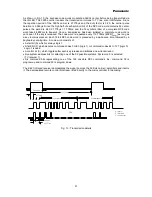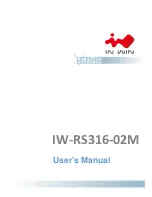
3DQDVRQLF
6
Original video signal
with/without ref. pulse
Demodulated signal on video output
Not optimal behaviour
Optimal behaviour
Ref
pulse
100%
Ref pulse 100%, luma 50%
Ref pulse, top white<100%
50%
100%
50%
a
100%
Top white AGC only
b
Ref
pulse
100%
Top white AGC
Black clamp AGC
50%
100%
50%
c
Fig 3: Top white and black clamp AGC
The Fig 3 “b” shows that the video amplitude is increased by the top white AGC, such that 100% white
is obtained. As a consequence the black level increases also.
The black level clamp AGC in “c” prevents this behavior and becomes automatically active if the video
black level on the video output increases.
In the external mode only the top white AGC is active. The black clamp AGC than is switched off
because the internal signal is not synchronized any more to the horizontal oscillator.
SECAM-L speed-up circuit:
In case of positive modulation and large reduction of the incoming IF-input level a speed-up circuit is
needed. This because the AGC action is slow since the AGC discharge current is small (450nA), for
minimizing the tilt.
The speed-up circuit measures the amplitude of the video output signal and will react after
approximately 60ms if the video output is continuously below 80% white level.
If the speed-up is activated the AGC capacitor will be discharged with a current of 50mA.
* Tuner AGC
The tuner AGC is provided to reduce the tuner gain and thus the tuner output voltage when receiving
strong RF signals. The tuner AGC takes over when the IF input reaches a certain input level, that can
be adjusted by I²C function AGC take over.
The tuner gain can be reduced by means of the open collector output pin 54.
* AFC
AFC output information is available for search tuning. With the alignment free concept this AFC
information is very accurate and derived via a counter. The AFC output is available by the I²C bus
outputs AFA, AFB.
The AFC window width can be increased by means of I²C bus AFW. This allows bigger frequency
steps during search tuning.
Notice: AFC information is updated once a field during the vertical retrace and only valid when the
coincidence detector is in-lock (SL=1)
* Video identification
The IF-part includes a stand-alone video identification circuit. This makes the ident function
independent of the sync part. The ident output is available by I²C bus, IFI, and can be used during
search tuning and for automatic sound mute in full scart application.
The video ident circuit measures the main frequency of the input signal, which should be
approximately 16kHz.The video ident. can be connected to the "internal" video signal or to the
selected CVBS input signal.
































